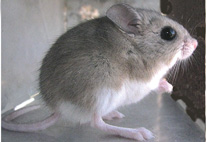Abstract
A small, new species of gerbil rodents of the genus Eligmodontia from the southwestern dunes of the Atacama Desert in northern Chile is described; the genus had not been reported for this western lowland region. Our description is based on cytogenetic and molecular data, as well as cranial and external morphology. In order to support this hypothesis, we studied 27 specimens captured in Playa Los Choros (Coquimbo) and Copiapó (Atacama), comparing them with samples of all the extant species of the genus. Nineteen individuals consistently showed 2N=50, FN=48, with telocentric chromosomes and G-bands identical to those of the geographically northeastern E. hirtipes; these two groups were geographically separated by E. puerulus (2N=34, FN=48). The phylogenetic analysis of 56 Eligmodontia cytochrome-b gene sequences yielded a maximum-likelihood phylogenetic tree where the new species formed a divergent and well-supported clade within the ge-nus, which was also confirmed by unweighted parsimony, minimum evolution, and Bayesian analyses. The new species has K2P genetic distances of 12.8% from the geographically distant E. hirtipes, and 10.3% from E. puerulus. Axes 1 and 2 of Principal Component Analysis based on 12 body and skull measurements clearly separated the new species, the latter having a smaller head+body length (70.6±3.4 mm, n=17) and lower weight (11.9±1.9 g, n=20). We provide strong evi-dence to recognize a distinct new western lineage within Eligmodontia genus, Eligmodontia dunaris sp. nov., for which we give a complete taxonomic description and a hypothetical biogeographic scenario. The new species should be consid-ered endangered, due to its level of endemism, its low population numbers (which can be occasionally increased after a blooming desert) and its fragile dry habitat patchily distributed near the Atacama Desert.

